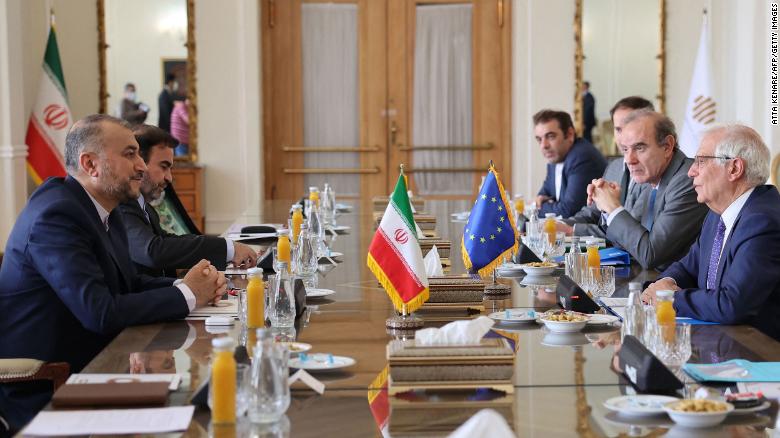
Abu Dhabi, UAE (CNN) – The United States and Iran could be heading for a summer of further escalation after indirect talks to restore the 2015 nuclear deal ended without any progress last week.
The talks — mediated by the European Union and hosted in Doha, Qatar — were the latest hope at getting both sides to come to an agreement as tensions around Iran’s nuclear program grow.
The two-day talks were aimed at resolving the remaining issues between the US and Iran. A senior American official said talks had gone “backwards” but Iran’s Foreign Minister Hossein Amir-Abdollahian said Saturday that “the path to diplomacy is open” and described the negotiations as “positive.”
Iran’s deputy foreign minister and top nuclear negotiator Ali Bagheri Kani said on Sunday that the time and place for the next round of negotiations are being finalized.
But as talks falter, Iran inches closer to the amount of enriched uranium necessary to build a nuclear bomb, and reduces cooperation with the United Nations’ nuclear watchdog, raising prospects of its adversaries resorting to military options to deter its nuclear capabilities.
CNN spoke with Ali Vaez, Iran Project Director at Crisis Group, a think tank in Washington, D.C., about what may happen next.
Since the talks ended without any progress, how likely is escalation going forward and what would that look like?
One thing is certain: the “no deal, no crisis” dynamic is not sustainable. With so much friction between Iran, the US and their respective regional allies, there is plenty of space for deliberate or unintended escalation that might spiral out of control. All of this is likely to turn the summer of 2022 [into one that is] quite similar to the summer of 2019, when tensions flared up in the form of tightening sanctions and attacks on international shipping lanes and Gulf Arab states’ infrastructure, bringing Tehran and Washington perilously close to open conflict multiple times during the course of just a few months.
The only difference now is that due to the ongoing dialogue between Iran and Saudi Arabia, as well as the UAE, the arena of competition is likely to shift to the Levant.
Does the lack of progress in Doha mean the deal is dead?
Not necessarily. Failure in this round could turn diplomacy with Iran into a zombie process for a while. Both sides will return home and will likely engage in mutual escalation in the hope that the other side would eventually blink first. But as we get closer to the midterm congressional elections, the Biden administration’s appetite for a deal could diminish. The problem is that the Democrats are bound to lose control over Congress in November, which in turn is going to diminish Iran’s interest in dealing with a lame duck administration that no longer controls Congress.
What happens next?
The Iranians are likely to decide to postpone the deal until the next US [presidential election in 2024], with their leverage intact. But the Iranians have their own presidential election in 2025 and would have to wait for that electoral outcome. By that point, the deal would be dead and the parties would have to negotiate a new one from scratch, which is likely to take a few years.
As such, the options are not between a deal now or six months from now, but rather it is between a deal now or six years from now. And given how close Iran already is to a nuclear weapon, the status quo is not sustainable. Sooner or later, Israel is likely to either take or encourage the US to take military action to set back Iran’s nuclear program, potentially triggering a disastrous regional conflagration.
What has the state of talks been since March and what led the two sides to meet in Doha?
In the past few weeks, the European Union’s chief negotiator, Enrique Mora, has been taking messages back and forth between Tehran and Washington to find a mutually acceptable formula. But long-distance diplomacy has proved slow and ineffective.
With growing concerns about Iran’s nuclear program in the West and in Israel, and Iran’s worsening economic situation under sanctions, both sides had an incentive to return to the negotiating table. The EU concluded that it would be much more efficient to facilitate the proximity talks with both sides in the same city rather than on two different continents.
Is the fact that the latest round of talks took place in a Persian Gulf country important?
It is significant for two reasons: first, it demonstrates how the regional context has changed compared to when the nuclear deal was finalized in 2015. Then, other than Oman, no other Gulf country was too keen on the deal, which they mostly saw as enriching and empowering a regional rival. Now, having lived through the Trump administration’s “maximum pressure” policy towards Iran that put them in the line of fire between Iran and the US, most Gulf countries understand the de-escalatory value of a deal.
What geopolitical factors have changed since March, when the US and Iran last held indirect talks?
Of course, the war in Ukraine has overshadowed everything. On the one hand, it has diminished the nuclear talks’ urgency and diverted the attention of western policy makers; on the other, it has rendered Iran’s return to the energy markets more valuable for the West.
This interview has been edited for length and clarity.




